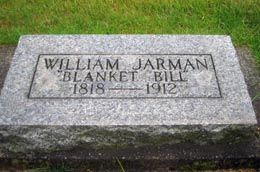On June 12, 1912, after a long and storied life filled with adventures, William "Blanket Bill" Jarman (1820-1912) dies at the home of his niece in Ferndale, Whatcom County. Beginning with his year of birth, the historical record on Jarman contains many contradictions, nearly as many as the man himself embodied during his journey from England to Washington Territory via Australia and Nootka Sound. Despite the disputed dates and events, the overall trajectory of Jarman's life encompasses the early spirit of seafaring, homesteading, and first contact with the Indian tribes of the Northwest. If merely half of the stories are true, Jarman stands as an exemplar of all that the word "pioneer" conveys.
Early Years and Adventures
Born in Gravesend, England on April 3, 1820, Jarman set out at age 17 by sea for Australia, where he deserted ship at Tasmania. He later boarded a whaling ship bound for the northern Pacific coast and arrived in Nootka Sound around 1846.
One of Jarman's essential experiences, as he and others related, was being taken captive by an Indian tribe around this time and held as a slave on Vancouver Island. Jarman maintained that he was held for two years (1846-1848) and ransomed for 32 blankets (this number, when stacked, approximated his height) by Governor Douglas at Fort Victoria, which earned him his nickname "Blanket Bill." In another telling, Jarman told an acquaintance that he was held on Graham Island in the Queen Charlotte Islands. He told a Bellingham friend that the Klallam on the Olympic Peninsula were his captors. Yet another person reported that Jarman told him it was in the San Juans that he spent years in captivity. Other sources describe a nine-year period of captivity and an Indian woman who saved Jarman during the attack after his mouth was pierced by an arrow, nursing him back to health and ultimately becoming his wife. At least one historian (Roth) places Jarman's two-year captivity starting in 1841, writing that by 1843, he was the first white man to explore Whatcom County (and also the first white man to visit the future site of Seattle).
In 1848, most sources agree, Jarman arrived at Point Wilson (future Port Townsend) via canoe. There, he stayed with the Klallam (or S'Klallam) Tribe until 1852, with a brief journey to California during its 1949 gold rush. In 1852, Jarman staked a claim (but ended up not proving up on it) on Samish Island with Alice, a niece of Klallam Chief S'Hai-ak (known to settlers as "King George"), and in 1854 they were married. Jarman began a trade business and was also contracted to deliver mail, traveling by sloop between Steilacoom, Port Townsend, and Whatcom.
Life in the Trades
During the mid to late 1850s, Jarman was principally engaged in hunting, fishing, and trapping around Whatcom County in support of his trade endeavors (some surmise he was a smuggler); an acquaintance attributed Jarman's nickname to his predilection at this time for wearing blankets in "the Indian style" or having his clothes sewn by Alice from blankets.
In the mid-1860s, Jarman found work supplying the construction crew for the Western Union and California State Telegraph companies that were laying line from Swinomish north to the Fraser River. In the spring of 1868, Jarman and Alice, with their daughter (also named Alice) ventured over Bow Hill from Edison and staked a homestead claim on a prairie that would bear his name to this day. Jarman spent most of the next five years in Whatcom, working for the Bellingham Bay Coal Company as a bartender for its saloon.
Jarman's Troubles
Court documents chart the next significant event in Bill Jarman's life: On the night of January 15, 1871, one of the saloon's patrons insulted Jarman's sister, a brawl ensued, and Jarman shot and killed Jim Farmer. Jarman was jailed and tried and let go on the verdict of justifiable homicide. He and Alice soon returned to their prairie homestead in the Samish area. Alice died there the following year.
In 1880, Jarman married Emily Plaster, a daughter of Ferndale Probate Judge John H. Plaster (1832-1898) and his Lummi wife. The couple lived for two years on the Lummi Reservation before Emily left Jarman, and Jarman left the area for Waldron Island, where he continued his smuggling ways.
Later Years
Jarman returned to England in the early 1890s, and came back to Whatcom County with his niece, Minnie Vine. In 1894, he moved to Ferndale to stay with his niece and her husband, William Manning, on their farm.
Neighbors and residents of Ferndale recalled Blanket Bill Jarman as a familiar figure around town, regaling people with the remarkable stories of his life and times. It was said that he preferred to walk to Bellingham rather than ride in a wagon or car or take the train. One friend of his niece remembered Jarman as "Buffalo Bill," for his mode of dress and demeanor.
In 1904, the Old Settlers Association of Whatcom County awarded Jarman the Neterer Loving Cup: He was the oldest living settler that year. His life was well summed up by Lelah Jackson Edson in The Fourth Corner: "Sailor, deserter, trader, hunter and fisherman, fur dealer, Indian slave, tribesman, squawman, homesteader, ship master, telegraph linesman, army courier and mail carrier, interpreter, bar tender, accused murderer, gold digger; there was little he did not find interesting and zestful" (Edson).
William Robert "Blanket Bill" Jarman died on June 12, 1912, and even in death, the record is not clear, for his gravestone in Ferndale's Woodlawn Cemetery lists 1818 as his birthdate.

